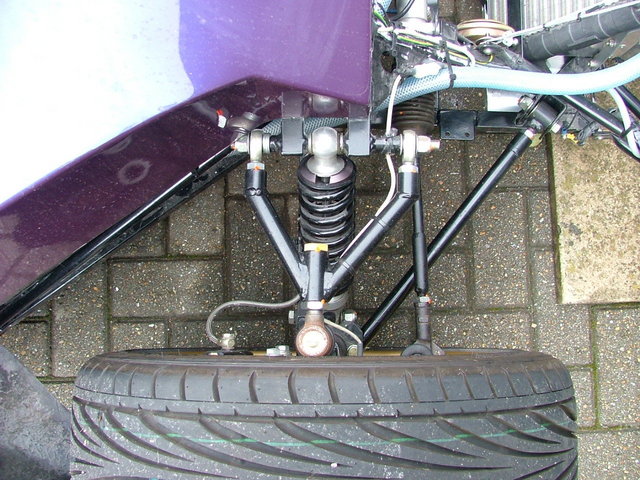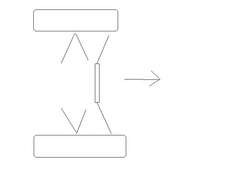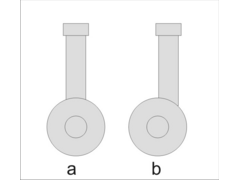
Chassis alignment in a middy
RazMan - 4/10/07 at 08:49 PM
I'm interested in how other middy builders set their cars up, particularly the front end camber, castor etc.
I'm having self centering issues which I would like to dial out if I can.
Here's my setup as it stands.
Ride Height - Front 120mm Rear 140mm
Camber - Front 1.75 degrees neg Rear 1 degree neg
Toe in - Front 0.5mm Rear 1mm
Castor - Nominal 4 degrees (dictated by Tina uprights)
Any suggestions? 
Chippy - 4/10/07 at 09:23 PM
Hi Raz. only an idea, worked on my car, but yours is rear engine, so questionable. I had S/C problems so put my front wheels at total upright,
"ie" zero camber, which helped, (gave SVA pass). The total cure was to remake my front bones with 6deg's of caster, although it did
pass SVA without them being remade, but wasn't happy myself . Cheers Ray
NeilP - 4/10/07 at 10:12 PM
Mike,
Too much or too little SC?...
Too little I assume in which case poss. too much neg camber reducing tyre contact patch and moving it inwards towards or even beyond virtual point of
force line from shock down through tyre i.e. slightly less neg camber moves the central point of the tyre contact patch outwards (by both physically
moving it and extending the size of the contact patch) beyond VP hence greater lever effect applied to wheel to centre?...
Or I could be talking [techfilter]nutsacks[/techfilter]
[Edited on 4/10/2007 by NeilP]
RazMan - 4/10/07 at 11:27 PM
Thanks for the input guys.
The self centering is not a big problem but I would just like to bring it more in line with a 'normal' car - tbh I am still amazed it got
through sva because it was even worse then!
The steering column was binding on the lower bush and replacing it with a spherical bearing improved it a little, but it's still not brilliant,
and I really need to concentrate when taking junctions sometimes. SWMBO is now making 'I wanna drive' noises so I would really like to sort
it out properly before she gets in the driving seat.
My upper wishbones are designed with adjustment in mind and I can dial in a little more castor but even 5/6 degrees didn't seem to make much
difference and just reduced the tyre clearance in the arch. I could try to reduce the camber a little and see what happens but I am rather reluctant
to make radical changes because these settings were supposed to be about right for a middy. The tyres are wearing pretty well although the rears are
showing signs of increased wear on the inside - maybe less camber there?
Perhaps another visit to a workshop with laser equipment is called for to re-check everything accurately - 10k miles can probably make a lot of
mountings settle a bit.
russbost - 5/10/07 at 08:01 AM
Increasing caster should improve self centering, sometimes quite a lot is required tho'
Fred W B - 5/10/07 at 08:02 AM
Hi Raz
I've sent you a mail that has 3 different approaches to setting up a GT 40, which might help
Cheers
Fred W B
RazMan - 5/10/07 at 10:29 AM
I managed to get in touch with the guy who originally set up my car a year ago and he tells me that the settings above are indeed a good starting
point.
To improve self centering I can use the lower trailing link to rotate the upright a bit more - anything over 4 degrees is considered a bonus but I am
going to just tweak it a little each time and see how it goes (I don't have any alignment equipment) This might move the tracking a little but my
local garage can handle that I think 
He also suggests reducing front camber to around 1.25 degrees and rear to 1 degree - this should also improve tyre wear a little at the expense of a
little less grip on the rear but probably only noticeable on the track.
Just to clarify, here is a pic of my setup (not my car though)
*edit* Thanks for the email Fred - very useful indeed 
[Edited on 5-10-07 by RazMan]


Rescued attachment Suspension top view front
v8kid - 5/10/07 at 10:42 AM
Hi Raz,
I had a similar problem with a past car and it turned out the rim offset was wrong. I managed to cure it by adding additional caster but it was never
really wonderfull. Can you borrow a wheel with a different offset and see if it cures it?
Cheers
Fred W B - 5/10/07 at 01:59 PM
Some others have asked so I'll post the GT40 info. It's just rough cut and pasted
Cheers
Fred W B
There is no definitive setting that will work for everyone and every situation ...if there were...all production/race cars would look and drive the
same ......and we all know there is no chance of that ........but here is a good place to start for an RCR....your results may vary
Front
Toe in 30 minutes
Camber -20 to -30 minutes
Castor 5-6 deg
Rear
Toe-in 20 minutes
Camber -10 to -20 minutes
Castor 5-7 deg
1 Deg = 60 minutes...
Ride height at Front axle CL 4 1/2 inches
Ride height at Rear axle CL 5 1/2 inches
Hope this helps.....
__________________
FRAN HALL replica manufacturer.....
Gt40
The car I built was set up as follows
KPI 5º34min
Camber -0º30min
Caster 6º
Toe In 0º30min
Scrub radius 110 mm (306mm Rol rad)
Steering arm 125mm
Ackerman was near zero (cant recall exact figure)
4º Roll gave 30' toe out
Standard Mk 2 escort rack
225/65-15 Avon front tyres
48% front mass
52% rear mass
Total mass 1250 kg c/w 68litres fuel and 2 occ
This was one handed steering at 140 mph. heavier at slower speeds but we drove all day in the Targa Tas and it was not tiring to drive.
Admittedly this was on road tyres. Certainly your car would be heavier steering with wider wheels and slicks but not that heavy.
My setup.
4 deg King pin
3 deg Caster
3 deg Ackerman
0 camber
20mm scrub
235's
2.7 turn 240Z rack
13 in steering wheel
easy to park, good turn radius
one handed steering at any speed
tracks nice, light and quick like a go kart.
britishtrident - 5/10/07 at 03:04 PM
One of of things that strike me first of all I suspect you may be getting unwanted toe-in when the the steering is turned.
The steering rack needs be moved back a bit relative to the track rod end ball centres.
should look more like this
[Edited on 5/10/07 by britishtrident]


Rescued attachment fre.JPG
RazMan - 5/10/07 at 05:03 PM
That's interesting, I haven't come across that suggestion before. I would be worried about introducing bump steer though and the rack would
be a real bitch to move now.
There is absolutely no bump steer with the current setup so I would imagine that any unwanted toe-in must be minimal except on full lock.
I notice there are two types of track ends. The type in the pic has a kink in it which throws the track arm forward a little (mine is central) Does
this affect anything?
I have managed to get an extra degree or so of castor by maxing out the trailing link adjustment. I think it MAY have improved the self centering a
tiny bit - could be my wishful thinking though 
I also checked the camber and while the fronts were ok, the rears were a long way out so they must have settled quite a bit (over 2 deg). I have now
corrected this but havent had a chance to road test yet.
[Edited on 5-10-07 by RazMan]
RazMan - 5/10/07 at 05:31 PM
I probably didn't describe the track rod ends very well so here's a pic
So what is the effect of using a or b?
*edit* Is it anything to do with the Ackerman angle?
[Edited on 7-10-07 by RazMan]


Rescued attachment Track Rod Ends.jpg
Doug68 - 8/10/07 at 10:34 AM
This is what I plan to do when I get to this stage. This is based on my GP250 motorcycle racing experience, setting a vehicle up at a race track can
be stressful event what with limited session slots and often limited run off. So it's to be avoided unless you have all day ready access to the
track.
Get yourself a g meter then book a day at skid pan, there must be one in Essex you can use I'm sure.
Come up with a plan (very important) to go through a full practical range of adjustments for what you can adjust and camber, tyre pressure etc
Drive around in 100' circles measure the g, write (very important) down what the car does and go until the you find the best combo.
Also make big adjustments, for example go from the highest tyre pressure to the lowest and then zero in the middle in say 5 psi steps or you wont be
able to feel the difference, which is just confusing.
Test all the setting even if you know they wont work, if you get what you expect from a setting then you've confirmed you understand the vehicle.
Finally do this where it won't hurt when you lose control as the point is to find out where exactly you lose control and what happens when you
do.
Fred's GT40 may well be close for me (thanks Fred). But I'd suspect you are carrying more rear weight and different tyre sizes to a typical
GT40 so they may be a bit off for you.
All of the above is just my HO






